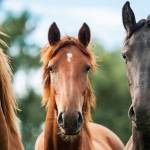Weaning Methods and Gastric Health of Foals

Every breeder exercises a certain measure of freedom in deciding when and how to wean foals. Researchers in Brazil recently evaluated the incidence of gastritis in foals subjected to two weaning methods.*
Gastritis is defined as inflammation of the mucosal lining of the stomach. Stress induces a series of events that often leads to gastritis. Discomfort associated with gastritis may decrease appetite which, in turn, can negatively influence foal growth. If gastritis is not resolved, ulceration may occur. Gastric ulceration in foals is a prevalent problem.**
In this study, researchers enrolled sixteen healthy five-month-old foals. Prior to weaning, all mares and foals were kept in a group pen throughout lactation. Two weaning methods were employed. In the first, eight of the foals remained in a group pen, and the mares were removed. In the second, the remaining eight foals were moved to individual pens with their dams two days prior to weaning for housing adaptation, and then the mares were taken away. All mares were moved 5 miles (8 km) from the foals, so they could not see or hear each other. Foals had been acclimated to forage and concentrate prior to weaning.
Researchers performed gastroscopy on all foals 15 days before and 15 days after weaning to determine the presence of gastritis. Inflammation was found in two areas of the stomach, the margo plicatus and the squamous region.
In reviewing the gastroscopies, researchers made other observations:
- A decrease in gastric lesions was noted between pre- and post-weaning periods for all foals; and
- A significant decrease in the intensity of lesions between the pre- and post-weaning period for all foals.
Given the incidence of gastritis found prior to weaning and the reduction of inflammation after weaning, researchers theorized that other stressors might have been at play before weaning. One thought surrounds the pecking order of mares. Foals from dominant mares have been known to nurse more than those of more submissive mares, possibly predisposing foals born to passive mares to long periods of fasting.
Moreover, the researchers noted that the foals weaned as a group consumed hay and concentrate much more quickly after separation—about seven hours—than those foals housed in individual pens. Those singly-housed foals did not consume feed for 48 hours after separation. Given this observation, foals may resume normal eating patterns more quickly when weaned in pairs or groups than individually.
Adding a research-proven supplement to the concentrate meals can be beneficial for foals as they prepare for weaning. At the top of that list is Triacton, a triple-action supplement designed to improve bone density and support the health of the stomach and hindgut.
*Campos de Araujo, A.M., A. Herculano de Silva, F.L. Bastos, J.T. Seidner, L.A. Jorge de Moraes Filho, R.R. Faleiros, A. Augusto de Oliveira Gobesso. 2022. Influence of weaning management on gastritis incidence in foals. Journal of Equine Veterinary Science 113:103917.
**Elfebein, J.R., and L.C Sanchez. 2012. Prevalence of gastric and duodenal ulceration in 691 nonsurviving foals (1995-2006). Equine Veterinary Journal 44:76-79.








